Killers of the Flower Moon : la face cachée de l’Histoire Américaine
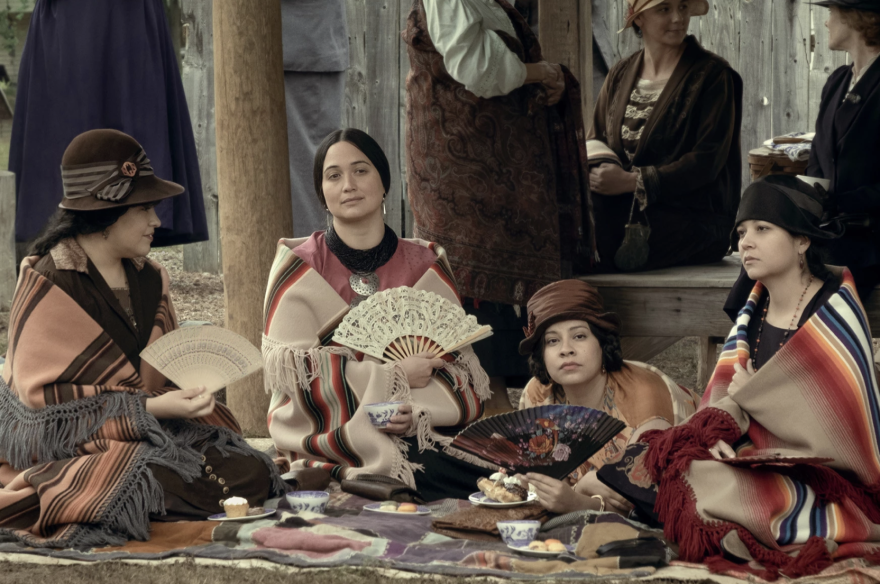
Nous sommes tous les tueurs (we’re all the killers) … et nous devons le comprendre. Nous devons l’affronter en nous-mêmes
M. Scorcese dans une interview à Sight & Sound
Lorsque l’on a vu Killers of the Flower Moon, le dernier film de Martin Scorsese, une scène reste en mémoire : King Hale (Robert De Niro), l’incarnation de “l’homme blanc” par excellence, regarde ses hommes brûler ses champs afin qu’il puisse toucher l’argent de son assurance. Une scène qui peut tout aussi bien être décrite comme une danse infernale d’ombres, une conjonction de corps qui, tels des diables, se déplacent dans l’obscurité au rythme de flammes, ravageant tout sur leur passage. Une scène tellement significative qu’elle se démarque du reste : le symbole des terres brûlées, rasées, volées exclusivement en quête de pouvoir et d’argent. Une histoire qui s’est répétée pendant des siècles sur l’ensemble du territoire états-unien.
En ce sens, Killers of the Flower Moon ne ressemble à rien de ce que Scorsese a pu faire pendant ses plus de cinquante ans de carrière (l’une des plus longues d’Hollywood). Avant tout, il s’agit de son premier western, même s’il a toujours été un grand admirateur du genre, qui transparaît dans l’ensemble de son œuvre. C’est aussi la première fois qu’il aborde la condition des Amérindiens et le génocide durant lequel ils furent exterminés tout au long de la construction de la “Nation Américaine”. Cela même s’il avait déjà travaillé avec des peuples indigènes dans d’autres projets (Kundun, Silence) et avait déjà voulu réaliser un film sur les Amérindiens de la Pine Ridge Reservation dans les années 70. Pourtant, à d’autres égards, son dernier film rappelle aussi tous ses précédents et, passée la sensation de renouveau, il peut être appréhendé comme le point culminant, l’aboutissement d’un propos muri depuis bien longtemps.
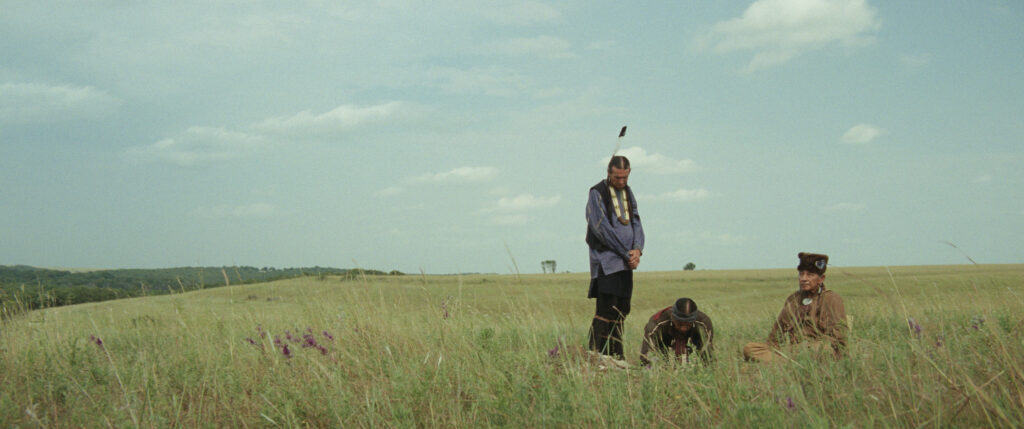
Les défis de l’adaptation littéraire
Killers of the Flower Moon est basé sur le livre de David Grann Killers of the Flower Moon: The Osage Murders and the Birth of the F.B.I. (ou La Note Américaine en français). Ce récit raconte comment, au début des années 20, de nombreux Amérindiens de la Nation Osage, à Oklahoma, furent brutalement assassinés après avoir fait fortune avec ce qui dans le film est désigné comme “l’argent du pétrole”. Un pécule obtenu grâce à d’importants gisements de pétrole découverts sur leurs terres.
Le livre de Grann détaille également comment le tout nouveau Federal Bureau of Investigation a enquêté sur les crimes commis contre les Osages et a contribué à la condamnation de leur maître d’oeuvre, l’infâme King Hale. Cependant, après de nombreuses réflexions, Scorsese et le scénariste Eric Roth ont décidé de s’écarter du matériau de base et préféré une adaptation plus libre de ce qui est arrivé à la tribu Osage. Ils ont ainsi relégué l’agent du FBI, Tom White, l’un des protagonistes du livre, à un rôle plus secondaire, afin d’éviter d’en faire le “white saviour” de l’histoire. Ce choix a permis de se concentrer davantage sur les personnages d’Ernest Burkhart (Leonardo DiCaprio), le neveu de King Hale, et de Mollie Kyle (la magnifique Lily Gladstone), une femme Osage, et sur leur histoire d’amour au milieu de toute l’agitation liée aux massacres.
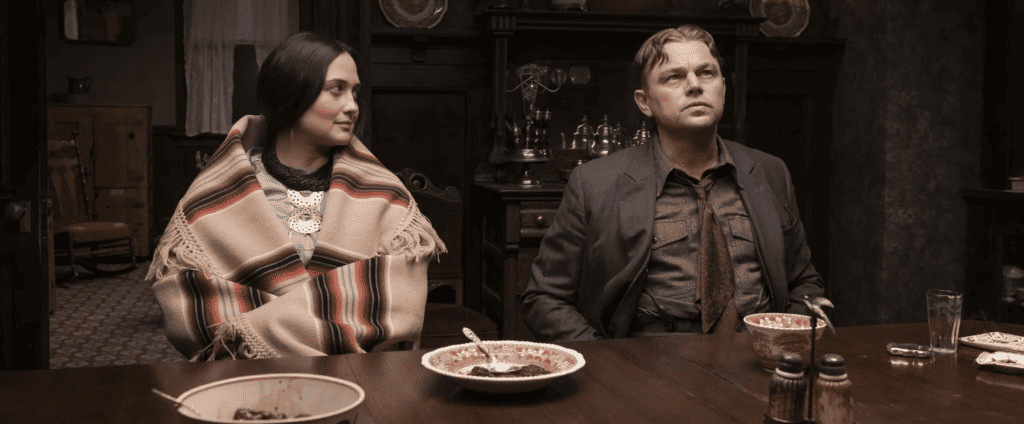
Ce changement radical dans le scénario de Killers of the Flower Moon a permis à Scorsese de s’intéresser de plus près à ce qu’a pu signifier pour la tribu Osage de voir leurs familles et amis assassinés de sang-froid tout en sachant que tous les habitants blancs de la ville, et même les autorités locales, étaient complices de ce qui arrivait.
Ainsi, c’est en suivant les péripéties de Ernest Burkhart, depuis son arrivé à Fairfax, Oklahoma, jusqu’à (spoiler alert) son mariage avec Mollie et sa participation au plan de son oncle consistant à tuer sa famille pour voler leur héritage, que Scorsese parvient à représenter les modes de vie et la cosmologie des Osage sans jamais abandonner son point de vue d’externe. Puisque, en fin de comptes, c’est ce qu’il est : un étranger qui veut raconter l’histoire de la Nation Osage aussi fidèlement que possible en les incluant dans le processus de création du film afin de ne pas manquer de respect à leur culture et leur passé.
Pour cela, la figure d’Ernest est extrêmement intéressante : un homme blanc qui a appris à parler la langue Osage ; à la fois un étranger et un membre de la communauté, un assassin mais aussi un mari et un père affectueux, même si la complexité du personnage de Leonardo DiCaprio ne peut pas être comparée à celui de Lily Gladstone. Mollie, toujours enveloppée dans un manteau traditionnel, lui donnant un air serein, voire céleste, est suffisamment sage pour sentir le “coyote” en Ernest, son côté cruel et avide, mais elle est également naïve et se laisse aveugler par l’amour qu’elle ressent pour son mari afin d’éviter de se confronter à toutes les atrocités que celui-ci commet au profit de son oncle.
Peux-tu trouver les loups dans cette image ?
Ainsi, la complexité des personnages de Killers of the Flower Moon permet aussi d’éclaircir le titre du film et son principal propos. Comme l’a dit Scorsese lui-même dans une interview à Sight & Sound, “Nous sommes tous les tueurs (we’re all the killers) … et nous devons le comprendre. Nous devons l’affronter en nous-mêmes”. L’Amérique, en tant que nation, s’est construite avec les actions et les inactions de ses peuples, avec ce qui est arrivé aux communautés amérindiennes et, dans de nombreux cas, avec ce qui se passe encore dans leurs réserves.
C’est en ce sens que le nouveau film de Scorsese n’est pas étranger au reste de son œuvre. Dans l’une des premières scènes du film, King Hale donne à Ernest un livre sur la nation Osage pour qu’il se familiarise avec leur culture et leur histoire (ce qui nous donne un aperçu de ce que nous découvrirons bientôt sont ses plans). On y trouve une photo de loups dans un champ, sous laquelle on peut lire la légende suivante : « Peux-tu trouver les loups sur cette image ?”. Et, c’est là le point commun des films de Scorsese : le fait qu’ils ont tous des loups. Des loups qui, poussés par leur soif de pouvoir et d’argent, se retrouvent entre les griffes d’une société capitaliste. Ce qui revient à dire que des loups comme ceux de The Wolf of Wall Street, si importants dans l’Américaine actuelle, ne sont pas si différents des coyotes de Killers of the Flower Moon, des bêtes sauvages qui chassent dans la nuit et hantent notre passé.
English version :
Killers of the Flower Moon: the hidden face of American History
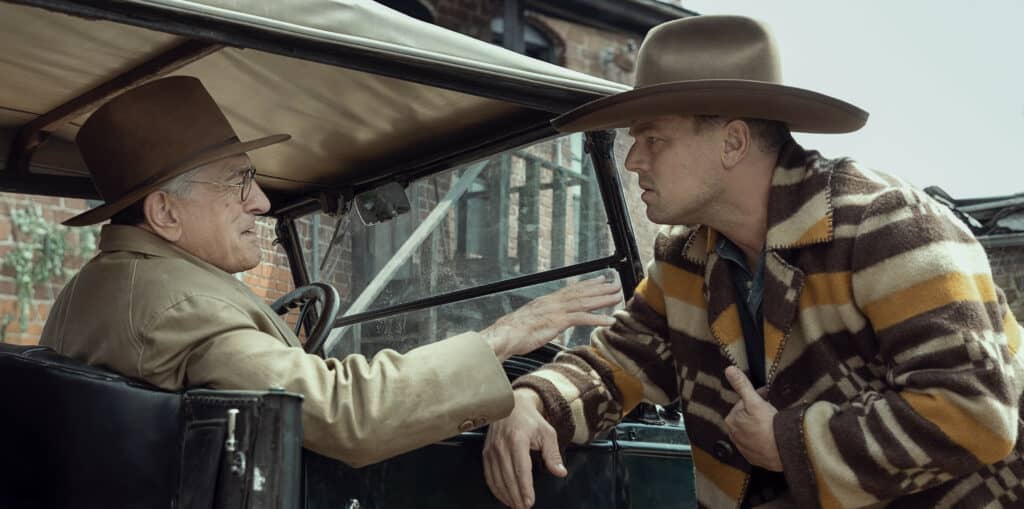
Can you find the wolves in this picture?
When thinking about Killers of the Flower Moon, Martin Scorsese’s latest film, there is a scene which is impossible not to come back to: King Hale (Robert De Niro), the great villain of the story, the “white man” par excellence, watches how his farm workers burn his fields in order for him to collect the insurance money. What follows could be described as a hellish dance of shadows coming straight from Dante’s Inferno, a conjunction of bodies moving in the dark, like devils, to the rhythm of flames that sweep everything in their path. A scene that bears so much meaning that it stands out from the rest. As it is a depiction of territories burned, razed, stolen for nothing but power and money. A story that repeated itself for centuries, along the length and breath of The United States.
In this sense, Killers of the Flower Moon is unlike anything Scorsese has done in his more than 50 years of career (by far, one of the longest in Hollywood). To begin with, it is his first western, although he has always been a great admirer of the genre with which he grew up and which unavoidably left its mark on his oeuvre. Then, it is also his first time making a film about Native Americans and the genocidal form in which they were decimated through the building of the “American nation”. Although he had worked with indigenous peoples before (Kundun, Silence) and had already wanted to do a film about Native Americans from the Pine Ridge Reservation back in the 1970s. However, in other ways, the film is also like anything Scorsese has done before and, leaving aside all of its freshness, could be seen as a culmination of something he has been working on for some time now.
Killers of the Flower Moon is based on David Grann’s nonfiction book Killers of the Flower Moon: The Osage Murders and the Birth of the F.B.I., an account of how, in the early 1920s, many Osages, from the Osage Nation in Oklahoma were brutally murdered after having become exceedingly rich with what is referred to in the film as “oil money”, a wealth they acquired by finding big oil deposits in their lands. Grann’s book also details how the newly formed Federal Bureau of Investigation investigated the crimes and helped to convict the mastermind behind all of them, the infamous King Hale. However, after giving it some thought, Scorsese and scenarist Eric Roth decided to rewrite their whole script for the film in favour of a freer adaptation of what happened to the Osage tribe. With this, they relegated FBI’s agent Tom White, one of the book’s protagonist, to a lesser role for him not to come out as the “white saviour” of the story and rather focus on the more enigmatic characters of Ernest Burkhart (Leonardo DiCaprio), King Hale’s nephew, and Mollie Kyle (the wonderful Lily Gladstone), an Osage woman, and their love story in the midst of all the turmoil of the mass-murders.
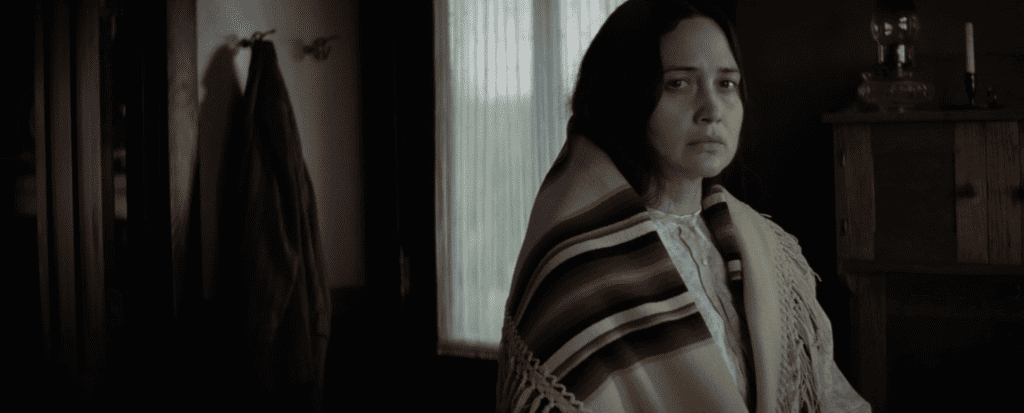
This radical change in Killers of the Flower Moon’s script allows Scorsese to nail down what it meant for the members of the Osage tribe to see their family and friends murdered cold-bloodedly while knowing that every white inhabitant of the village, and even the local authorities, were complicit in what was happening. And, by following Ernest Burkhart’s peripeteias, from his arrival to Fairfax, Oklahoma, to (spoiler alerts) his marriage to Mollie and his partaking in his uncle’s plan to murder her family and stay with her inheritance, he is able to portray from up close the Osage’s way-of-life and cosmology without ever leaving his outsider’s point of view. Because, at the end of the day, that is what he is: an outsider who wants to tell the story of the Osage Nation as truthfully as possible, by including them in the creative process of making the film in order not to be disrespectful of their culture and history.
With this, Ernest’s character turns out to be an interesting one: a white man who learnt to speak the Osage language, at once an outsider and an insider, a murderer but also a loving husband and father. Still, at least to my eyes, not even Leonardo DiCaprio’s character complexity is able to match the overwhelming effect that Lily Gladstone’s sole presence creates. Mollie, always wrapped in a traditional blanket, which always gives her a serene almost celestial look, is wise enough to sense the “coyote” that is in Ernest, his evil and greedy side, but she is also naive enough to let her love for him blind her of all the atrocities he committed for his uncle.
At the end of the day, that complexity behind Killers of the Flower Moon’s characters is also the one who helps to illuminate the film’s title and main purpose of existence. As Scorsese himself told in an interview to Sight & Sound, “we’re all the killers… and we have to understand that. We have to confront it in ourselves”. America as a nation was built with its peoples’ actions and in actions, with what happened to Indigenous communities and, in many instances, to what is still happening in Native American reservations.
It is in this sense that Scorsese’s new film is not alien to everything he has done before. In one of the film’s first scenes, King Hale gives Ernest a book about The Osage Nation, for him to become familiar with the culture and history (giving us a hint of what we’ll soon find out are his plans). In it, there’s a picture of wolves in a field under which it can be read the caption: “Can you find the wolves in this picture?” And, that’s what many of Scorsese’s films have in common: they all have wolves, and all of them, in their greed for power and money, get caught between capitalism’ claws. Which means that wolves like those from The Wolf of Wall Street, which today are so essential for American society, are not so different from the coyotes of Killers of the Flower Moon, wild beasts which hunt in the night and haunt our past.